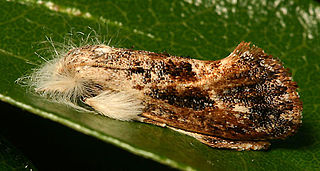
The semipalmated sandpiper is a very small shorebird. The genus name is from Ancient Greek kalidris or skalidris, a term used by Aristotle for some grey-coloured waterside birds. The specific pusilla is Latin for "very small".

The field sparrow is a small New World sparrow in the family Passerellidae. It is about 140 mm (6 in) long and weighs about 12.5 g (0.4 oz). The head is grey with a rust-coloured crown, white eye-ring and pink bill. The upper parts are brown streaked with black and buff, the breast is buff, the belly is white and the tail is forked. There are two different colour morphs, one being greyer and the other more rufous.

The steppe pika is a small mammal of the pika family, Ochotonidae. It is found in the steppes of south Russia and northern Kazakhstan.

Acrolophus is a genus of moths in the family Acrolophidae, with, typically, great individual variation within species in color pattern, making field identification of many individuals difficult or impossible. It was described by Felipe Poey in 1832.
Acrolophus acanthogona is a moth of the family Acrolophidae. It is found in Texas.

Acrolophus popeanella is a moth of the family Acrolophidae. It is found in the eastern United States, from New Jersey and Ohio south to Florida and west to Illinois, Nebraska and Texas.
Acrolophus fervidus is a moth of the family Acrolophidae described by August Busck in 1912. It is found in Costa Rica, Mexico and Texas.

Acrolophus arcanella is a moth of the family Acrolophidae. It is found in eastern North America.

Acrolophus texanella is a moth of the family Acrolophidae. It is found from Maryland to Florida and to Texas.
Acrolophus macrogaster is a moth of the family Acrolophidae. It is found in North America, including Arizona.
Acrolophus propinqua is a moth of the family Acrolophidae. It is found in North America, including Alabama, Florida, Georgia, Illinois, Louisiana, Maryland, Mississippi, New York, Ohio, South Carolina, Tennessee, Virginia and West Virginia.
Acrolophus crescentella is a moth of the family Acrolophidae. It is found in North America, including Arizona.
Acrolophus echinon is a moth of the family Acrolophidae. It is found in Mexico.
Acrolophus harparsen is a moth of the family Acrolophidae. It is found in Puerto Rico.
Acrolophus mimasalis is a moth of the family Acrolophidae. It is found in the West Indies.
Acrolophus noctuina is a moth of the family Acrolophidae. It is found in the West Indies.
Acrolophus occultum is a moth of the family Acrolophidae. It is found in the West Indies.
Acrolophus pristinella is a moth of the family Acrolophidae. It is found in Venezuela.
Acrolophus walsinghami is a moth of the family Acrolophidae. It is found in Puerto Rico.

Kogia pusilla is an extinct species of sperm whale from the Middle Pliocene of Italy related to the modern day dwarf sperm whale and pygmy sperm whale. It is known from a single skull discovered in 1877, and was considered a species of beaked whale until 1997. The skull shares many characteristics with other sperm whales, and is comparable in size to that of the dwarf sperm whale. Like the modern Kogia, it probably hunted squid in the twilight zone, and frequented continental slopes. The environment it inhabited was likely a calm, nearshore area with a combination sandy and hard-rock seafloor. K. pusilla likely died out due to the ice ages at the end of the Pliocene.







